This years APTA Commuter Rail Conference that was being held at the Westin Bonaventure Hotel in downtown Los Angeles.
SATURDAY, APRIL 2 TECHNICAL TOUR Alameda Corridor"The combined Ports of Los Angeles and Long Beach provide the largest single source of goods from the Far East to the United States. Today, this volume of freight is a critical factor in the provision and growth of passenger rail service in the Los Angeles region. This tour will take participants down the Alameda Corridor to the Port of Los Angeles, where participants will see the tremendous logistical challenges faced by the region. The tour will also include a harbor cruise aboard a charter boat to see the port "up close."
"Transportation: At 7:30 A.M. tour participants will travel from the Bonaventure Hotel to Union Station by bus, where they will board a Metrolink train to travel the Alameda Corridor. Continental breakfast will be provided on-board. Upon arrival at the harbor, participants will board a charter boat and tour the Ports of Los Angeles and Long Beach. Participants will return to Los Angeles Union Station via Metrolink and to the Bonaventure Hotel via bus or Metro Red Line."{The above two paragraphs from the APTA Web 2005 Conference Web Site}
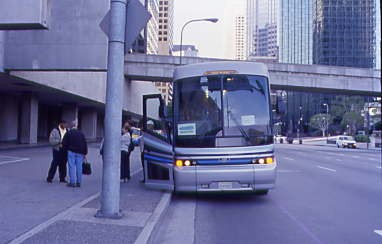
Some of the passengers like myself arrived early for the tour and we checked off the list just as one of the busses arrived to take us to Union Station.
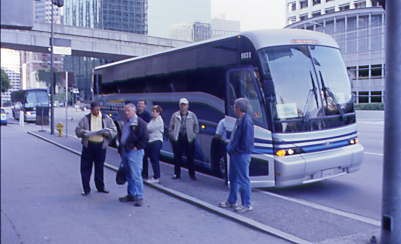
Members of the APTA Conference board the first bus. Downtown Los Angeles was deserted early on this Saturday morning. The bus took us to the Gateway Entrance to Los Angeles Union Station. We followed one of our fantastic APTA group leaders who led us down the tunnel to Track 6.
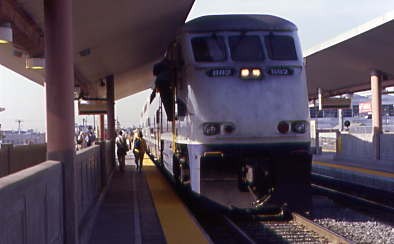
Our Metrolink Train waited for our departure on Track 6.
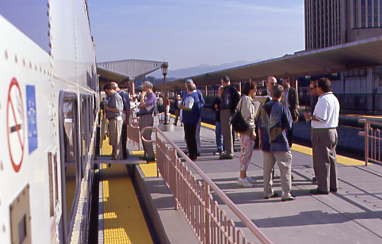
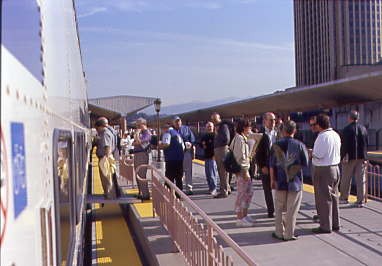
Members of our tour group board our special Metrolink Train.
The Alameda Corridor is a 20-mile freight rail expressway between the neighboring ports of Los Angeles and Long Beach and the transcontinental rail yards and railroad mainlines near downtown Los Angeles. The Mid-Corridor-Trench that contains the below-ground railway that is 10 miles long, 30 feet deep and 50 feet wide. By consolidating 90 miles of other rail lines into a high-speed expressway, the Alameda Corridor eliminated conflicts at more than 200 at-grade railroad crossings where cars and trucks previously had to wait for long freight trains to slowly pass. Train travel from the harbor to the mainlines in Los Angeles were cut by more than half to now only about 45 minutes. This then cut locomotive emissions by 28 percent. Since the start of operations on April 15, 2002, the Alameda Corridor has handled an average of 35 train movements per day a figure consistent with earlier projections for this stage of operations. Usage is projected to increase steadily as the volume of international trade through the ports grows. The ports project the need for more than 100 train movements per day by the year 2020. The Alameda Corridor can accommodate approximately 150 train movements per day. The Alameda Corridor is intended primarily to transport cargo arriving at the ports and bound for destinations outside of the five-county Southern California region (imports) or originating outside the region and shipped overseas via the ports (exports). This accounts for approximately half of the cargo handled by the ports. The other half of the cargo handled by the ports is bound for or originates in the region and that cargo is transported primarily by truck.
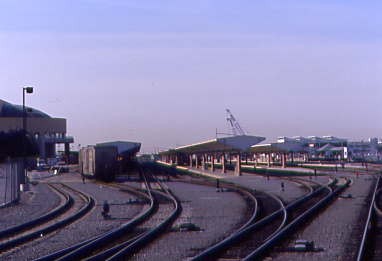
We departed the Los Angeles Union Station at 8:03 AM for our unique trip down the Alameda Corridor. Don Davis of the Alameda Corridor Transportation Authority gave as a narrative journey as we traveled south down the corridor.
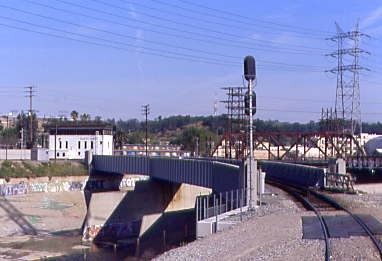
The train passed Mission Tower and crossed the Los Angeles River before running south down
the east bank.
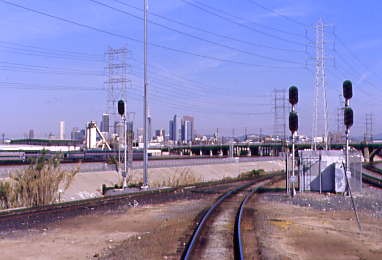
We prepared to leave the east bank at Ninth Street to take the connection to the Alameda Corridor with the skyline of downtown Los Angeles in the background.
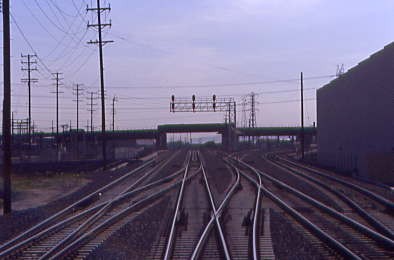
We next crossed the Los Angeles river again, went under the Metrolink Flyover, by the Redondo Tower and the BNSF connection to the Alameda Corridor.
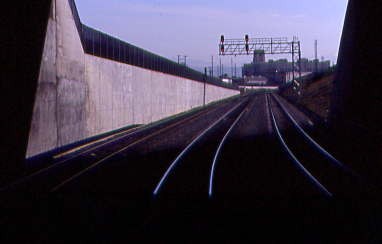
Our train descended into the ten mile trench below all the streets.
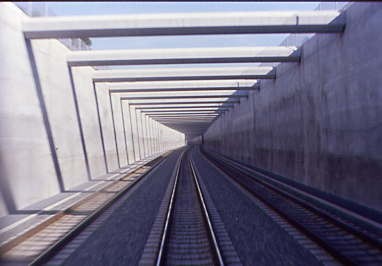
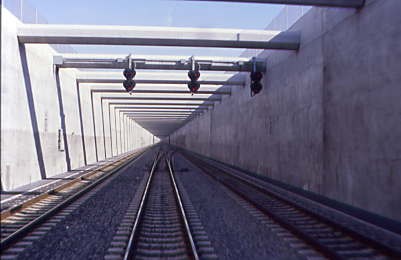
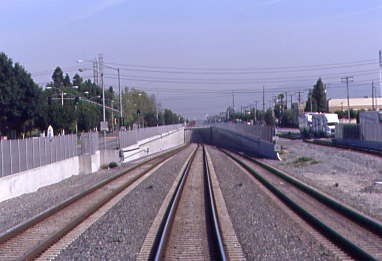
Rear door views going south down the Alameda Corridor to the end of the trench.
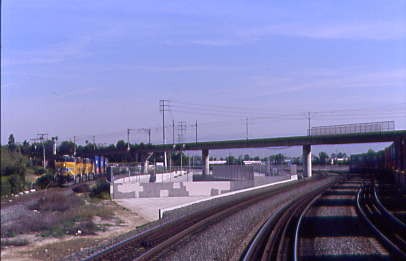
The Alameda Corridor is then joined by the Wilmington Line with a UP Freight waiting for our special to clear out of their way. Andrew Fox of the Pacific Harbor lines took over giving the narration and was very interesting.
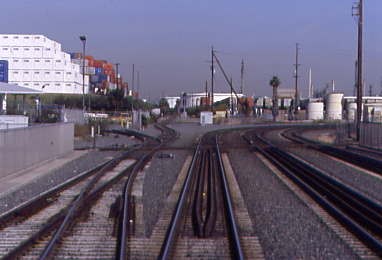
West Thenard as the train rolled along to San Pedro.
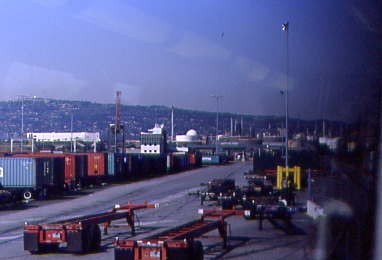
View of a container dock as we traveled along the former Pacific Electric West Basin Line.
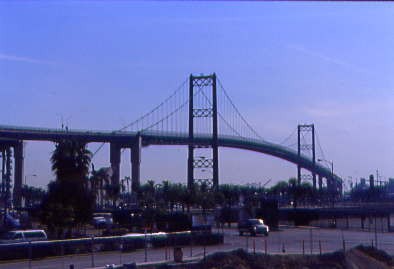
The Vincent Thomas Bridge as seen from the train.
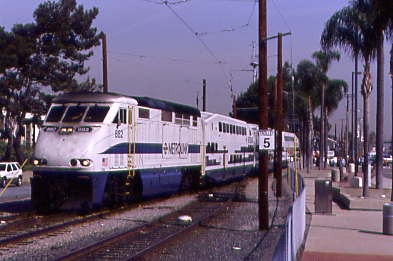
The first time a Metrolink Train has ever been to San Pedro taken after it dropped off all of the passengers. We were then all led across the street to the Harbor Cruise Boat "Spirit".
"The Port of Los Angeles, Southern California's gateway to international commerce, is located in San Pedro Bay, just 20 miles south of downtown Los Angeles. This booming seaport not only sustains its competitive edge with record-setting cargo operations, but is also known for its groundbreaking environmental initiatives, progressive security measures and diverse recreational and educational facilities."
"The Port of Los Angeles is a department of the City of Los Angeles and is often referred to as the Los Angeles Harbor Department. The Port is operated and managed under a State Tidelands Trust that grants local municipalities jurisdiction over ports and stipulates that activities must be related to commerce, navigation and fisheries. A five-member Board of Harbor Commissioners are appointed by the Mayor and confirmed by the Los Angeles City Council to provide direction and create policy for the Port. As a proprietary and self-supporting department, the Port is not supported by taxes. Instead, revenue is derived from fees for shipping services such as dockage, wharfage, pilotage, storage, property rentals, royalties and other Port services. Considered a landlord port, the Port of Los Angeles leases it property to tenants who then, in turn, operate their own facilities."
"The Port encompasses 7500 acres, 43 miles of waterfront and features 26 cargo terminals, including dry and liquid bulk, container, breakbulk, automobile and omni facilities. Combined, these terminals handle nearly 150 million metric revenue tons of cargo annually. Last year, the Port moved an impressive 7.4 million TEUs, establishing a new national container record once again. The Port is also home to the nation's most secure cruise passenger complex, the World Cruise Center."{Taken from the Port of Los Angeles Web Site.}
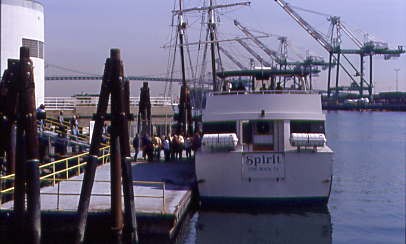
Our Tour Group Members boarding the Spirit. We would now begin our tour of the Los Angeles and Long Beach Harbors.
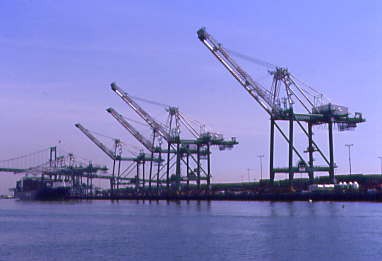
Container Dock Cranes against a beautiful sunny California Sky.
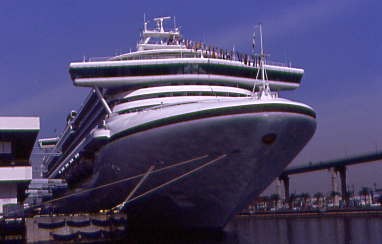
At the Cruise Ship Dock was the Diamond Princess. Princess Cruises is one of five cruise
ships lines that use the harbor for docking.
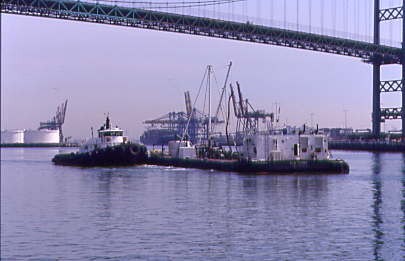
A Bunker Barge or floating fuel station passed our boat on the way to refuel another vessel.
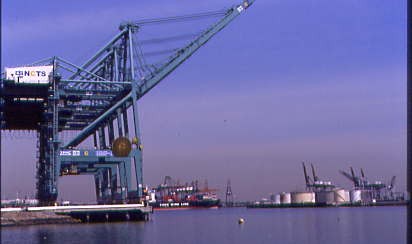
The Greca Terminal is unique to the harbor as when unloading the ships engines are turned off and electrical power from the LA DWP is used for the ship's power while in port. This new technology is more environmental friendly as it eliminates engine pollution that the ported ship would normal produce.
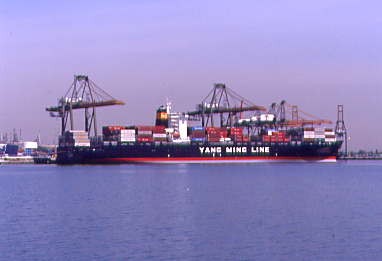
The LA Harbor West Basin with a ship of the Yang Ming Lines.
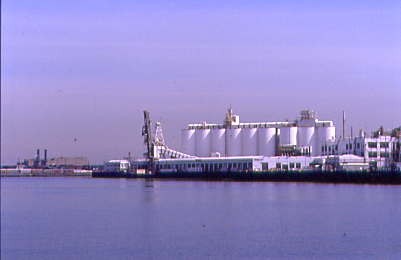
The white tanks are Borax Tanks and is the only privately owned dock in Los Angeles Harbor. The materials are shipped by rail from the High Desert of California.
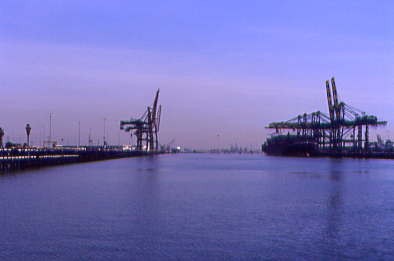
Our boat headed down the East Channel to the north of Terminal Island and passed the NYC Lines Artemis unloading.
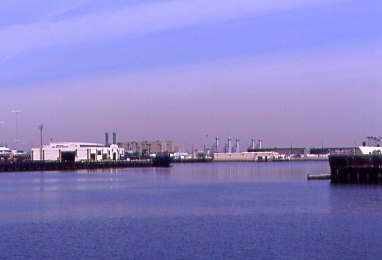
Port of Los Angeles Berth 180.
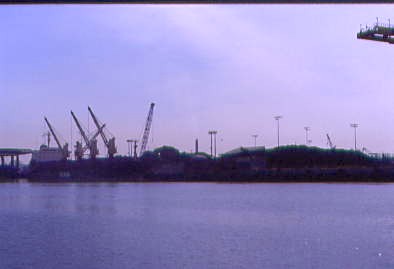
Piles of scrap steel heading to Asia were being loaded onto the Fesco 06B.
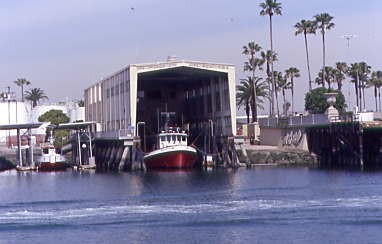
All around both harbors are fire boat stations. Here is the LA City Fire #4 Station.
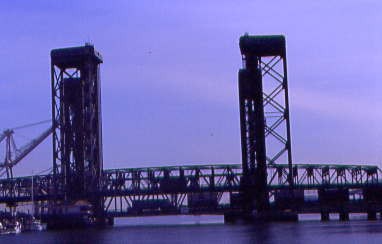
The Badger Bridge which is the only rail access to Terminal Island. We were stopped by a Pacific Harbor train pushing cars of containers onto the island.
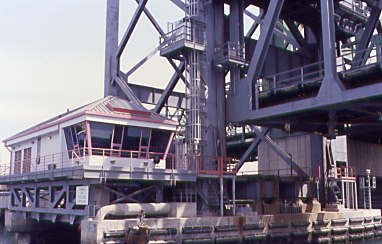
The Badger Bridge then lifted up and we passed through to enter the Long Beach Harbor.
"The Port of Long Beach is one of the world's busiest seaports, a leading gateway for trade between the United States and Asia. Long Beach is the United State's second busiest port. Long Beach is the world's 12th busiest container cargo port If combined, the ports of Long Beach and Los Angeles would be the world's third-busiest port complex, after Hong Kong and Singapore. East Asian trade accounts for more than 90% of the shipments through the port. Top trading partners are China/Hong Kong, Japan, South Korea and Taiwan."
"Leading Exports by tonnage: Petroleum coke, petroleum, wastepaper, steel, plastics, chemicals, hay, sulfur, fruit and nuts, cotton. By value: Machinery, plastics, electric machinery, meat, chemicals, vehicles, fruits and nuts, cotton, hides and medical equipment."
"Leading Imports by tonnage: Petroleum, furniture, machinery, electric machinery, cement, steel products, plastics, vehicles, toys and chemicals. By value: Machinery, electric machinery, vehicles, clothing, toys, furniture, shoes, petroleum, plastics and medical equipment." {Information taken from the official Port of Long Beach Web Site.}
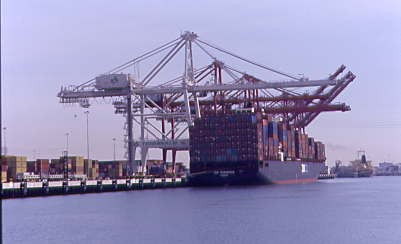
Mediterranean Line "Zim Ure Zim" unloading at their dock.
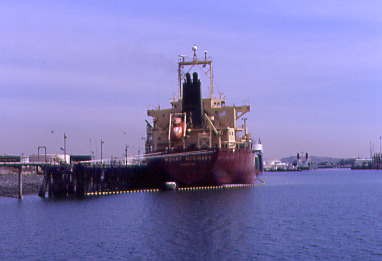
The "Mount McKinley" at dock.
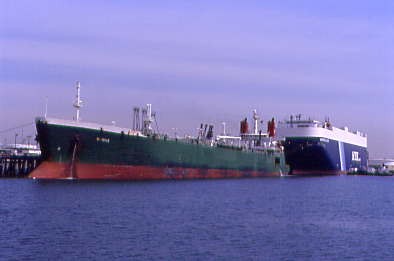
Mobile Oil Tanker "Li Massol" and the NYK Line Auto Carrier. Autos are both imported and exported for both harbors.
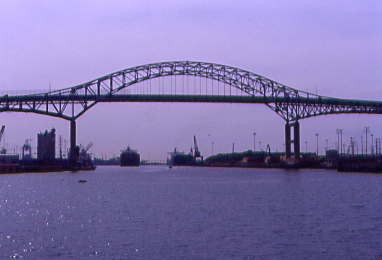
The Gerald Desmond Bridge with the MSC Atlantic approaching from the south with another scrap steel loading port on the right.
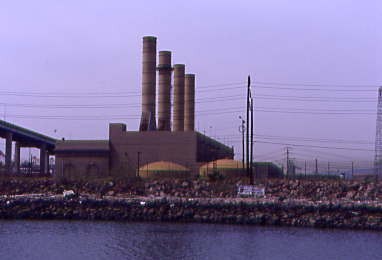
The Edison Steam Power Plant which has sank 29 feet over the years. This power plant can be fired up at anytime especially during ''Blackout" periods in Southern California.
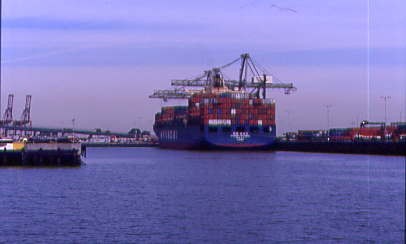
Hy Undai "National" at port loading.
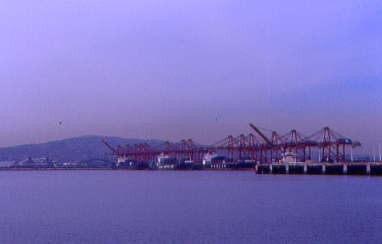
Hajan Terminal on Terminal Island.
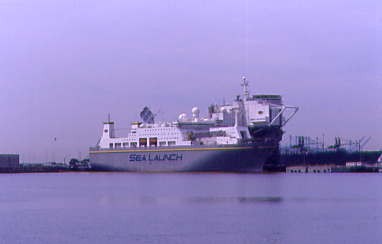
Boeing Sea Launch Base. Satellites are taken from here to the Equator for launching. 10 to 12 launches are planned for 2005.
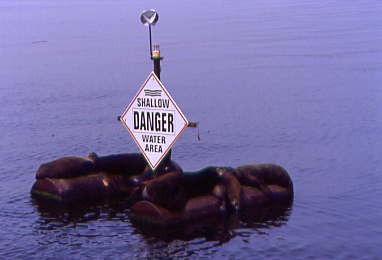
Both Harbors protect nature to the fullness. Sea Lions enjoy the sunshine on one of the buoys. There are also bird preserves located in the harbor.
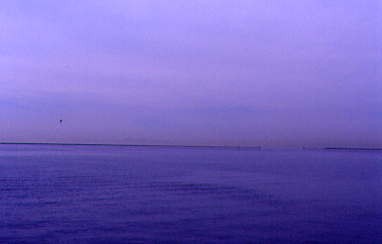
The view towards the nine mile breakwater with three openings that protect the harbor from
the full force of the Pacific Ocean.
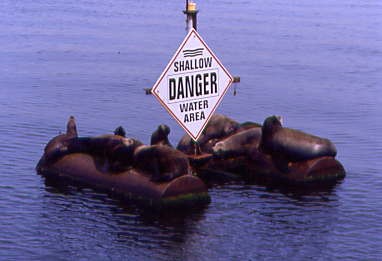
Another buoy, more Sea Lions.
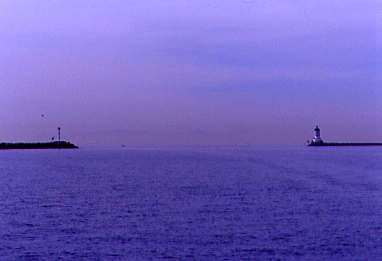
The Angel Entrance to Los Angeles Harbor with Angel Gate Lighthouse protecting the opening with its green light.
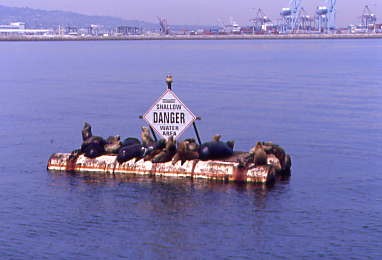
Sea Lions on another buoy with Terminal Island in the background.
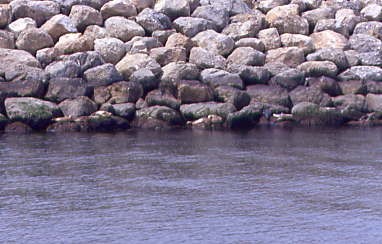
On a rocks along the shore of Terminal Island California Seals enjoy this beautiful Saturday.
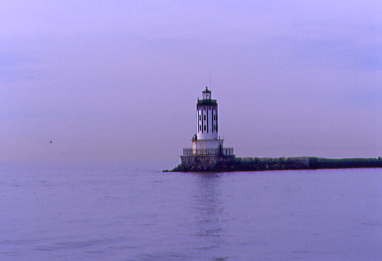
A close up view of Angel Gate Lighthouse.
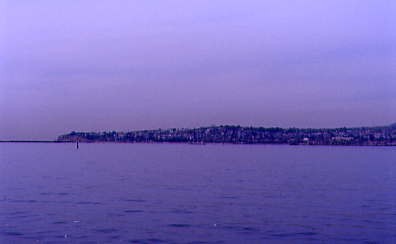
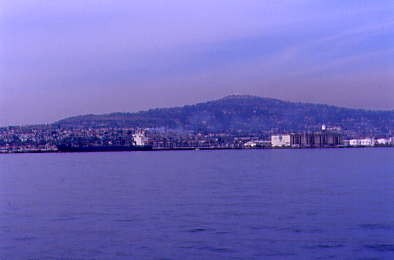
The view looking west towards San Pedro.
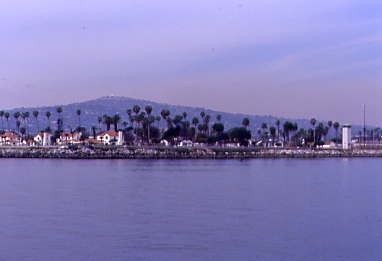
The houses for the staff of the Terminal Island Federal Prison.
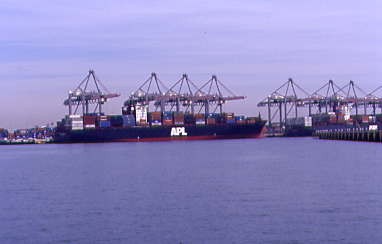
American President Lines{APL} at Pier 400 on Terminal Island.
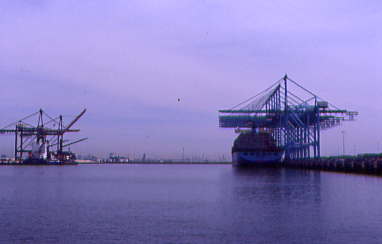
The "Susan Maersk Hellerup" unloads at the Maersk Dock at Pier 300 on terminal Island. This part of the harbor also has a bulk loading facility for coal and other materials.
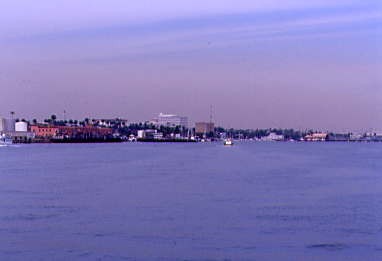
Returning to San Pedro from where we started after touring the harbor all the way around Terminal Island.
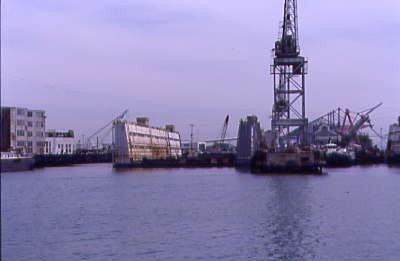
The port has several "Dry Docks" to repair ships in need. We then returned to the dock where our group split up . Most people went to get lunch or visit the area attractions.
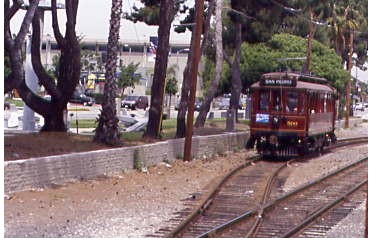
Some of the group choose to ride the San Pedro Waterfront Streetcar Line.
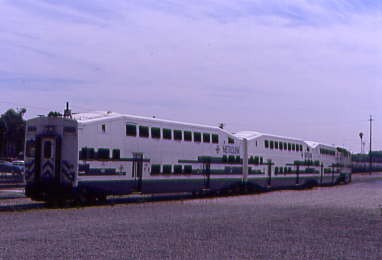
The waiting Metrolink train that would take us back north to Union Station the same way
we came, up the Alameda Corridor. A good time was had by all on the unique rail tour
of the Alameda Corridor and the fantastic boat tour of Los Angeles/Long Beach Harbors.
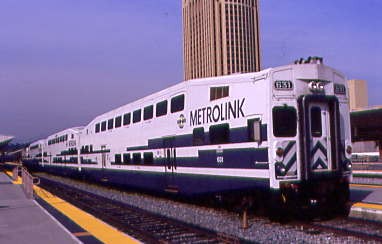
The Metrolink train returned all to Los Angeles Union Station to a waiting bus back to the Westin Bonaventure Hotel ending a fantastic APTA Tour of the Alameda Corridor.
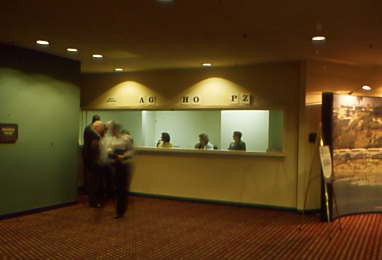
I came down to the APTA Convention Registration Desk to sign in and to pay for that great APTA Alameda Corridor Trip.
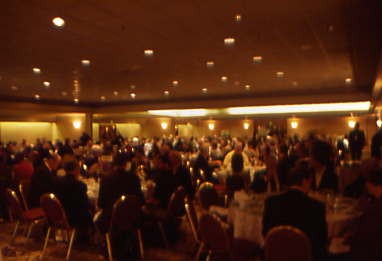
Sunday's main event of the 2005 APTA Conference was the Grand Lunch with the main speaker being a personnel hero of mine that basketball legendary coach John Wooden of UCLA fame. I was joined at my table to enjoy this event by Susan Berlin of the APTA along with their photographer Christopher Loudahl. Also at my table from the Washington Group was Timothy Maurier, Joseph Alexander, Donald Nelson and Jesse J Diaz. The Washington Group specializes in transportation projects dealing with their infrastructure, engineering and building of projects around the United States. They are under contact for the operation of the New Jersey Transit Hudson-Bergen Light Rail Line. They also built the Pasadena Gold Line in Los Angeles and is currently working on the extension of the Gold Line to East Los Angeles. Lunch was a delicious chicken platter with a very tasty cheesecake for dessert.
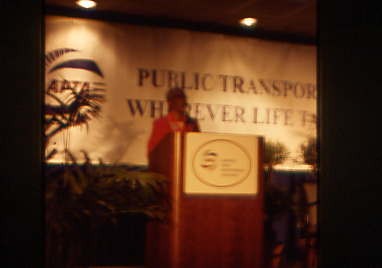
Kathryn D. Waters welcomed everyone to the 2005 APTA Commuter Rail Conference and informed us that this would be the last solo Commuter Rail Conference.
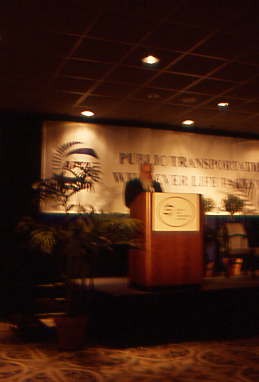
Art Brown, the chairman of the SCCRA{i.e. Metrolink} spoke briefly next. He stressed that we must educate the Administration and Congress about the very important relationship between Commuter Rail and Amtrak. A short music video about Metrolink was shown to the audience on a large projection screen.
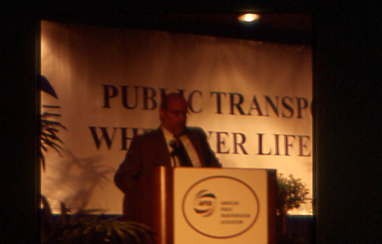
David Slow the Chief Executive of the SCCRA was an original member of the team which started Metrolink. He told of Metrolink starting with just eleven stations and now has fifty-three soon to be fifty four.
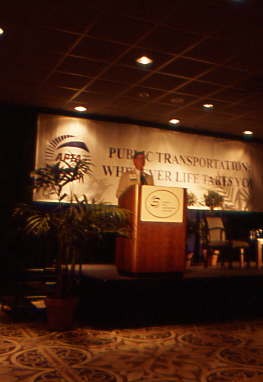
It was then time for Larry Shaw to introduce our Main Speaker, the world renowned former college basketball coach, John Wooden, an American Treasure.
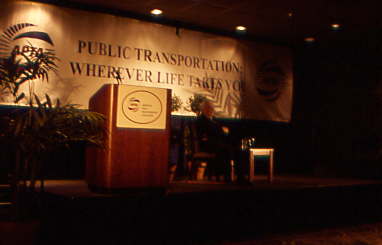
He spoke to us about what it takes to succeed in life. Something we should all aspire to attain is success. Success is never trying to be better than anyone else in life. Always learn from other people. He then said a short verse:
At God's footstool to confess, a poor soul knelt to and bowed his head, "I failed", He Cried. The Master said, "Thou didst thy best, that is success!"
Peace of mind comes from knowing you did the best you can. Happiness in your heart comes from knowing that you did your best. For a plan to success John came up with his idea for the "Pyramid of Success."
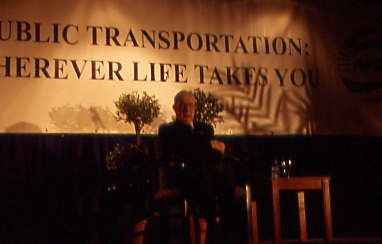
The base or foundation has at one end "Enthusiasm" and at the other "Industriousness". In between these important ideas are the ideas of "Friendship, Loyalty and Cooperation." The second level has "Self Control, Alertness, Initiative and Intentness". On one end is the idea of "Ambition" and on the other end "Sincerity." The third level has "Condition, Skill and Team Spirit". One end of this level as "Adaptability" while the other has "Honesty." The fourth level is "Poise and Confidence" braced by "Resourcefulness" on one end and "Reliability" on the other. The top level of the "Pyramid of Success" is "Completive Greatness" surrounded by "Fight, Faith, Patience and Integrity". It was fascinating to hear how John explained his "Pyramid of Success". He opened it up to questions from the audience. John was asked about the Lakers and stated they could use some good old fashion teamwork. I had a chance to ask John a question which was: "Coach Wooden, you have seen thousands of basketball players in your great career. In your opinion, who was the best Guard, Forward or Center that you have ever seen play basketball?
He thought for a moment and said, "Center, that would be Bill Russell as he caused the game of basketball to be changed forever. Forward, a quick pause, Larry Bird as he was the most natural player, not great athletic skills but a true love of the game. Guards, Oscar Robertson, Jerry West and Michael Jordan, who was the best all around player ever. If I was going to have an All Star Team I would also include Lew Alcindor and Bill Walton."
I always wanted that question to be answered and thanks Coach Wooden for his answer. That was the final question of the lunch and with it I walked back to the Red Line Subway Metro/ 7th Station to get to Union Station for the APTA 2005 Equipment Display.
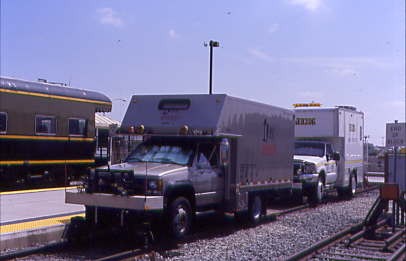
ORMV2 Advanced Rail Management Cooperation and HRZ118 Herzog Rail Testa.
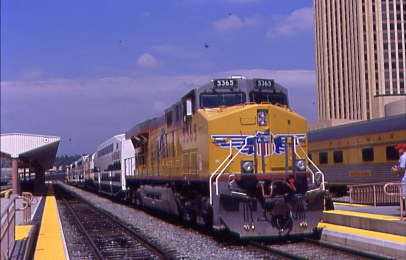
UP 5365 led one display track with Metrolink Coach 171, Metrolink 800 F-40PH, Metrolink Cab Car 602, Metrolink Coaches 201 and 204 with Metrolink 884 F-69PHI.
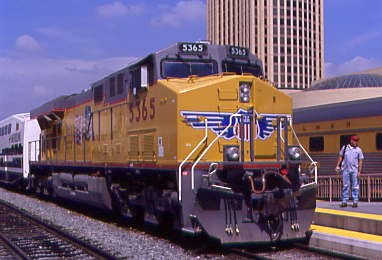
The Union Pacific 5365, a C45ACCTE.
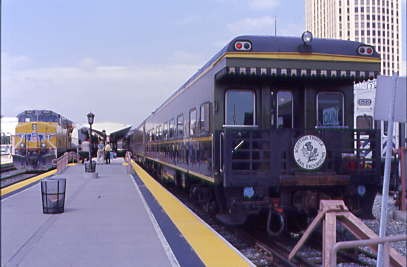
The Scottish Thistle led Private Car Pacific Sands, Overland Trail and Colonial Craft along with Superliner Coach 34109, Surfliner Cafe/Coach 6307 and Surfliner 463, an F-69PHI.
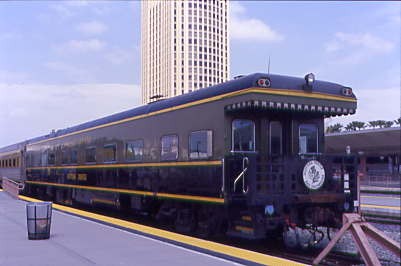
The Scottish Thistle.
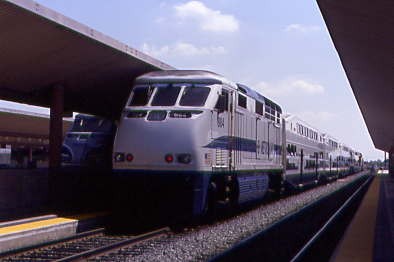
The Metrolink 884 holds one end of the line while to the left Surfliner 463 holds the other. I boarded Surfliner 580 a few minutes later for home.
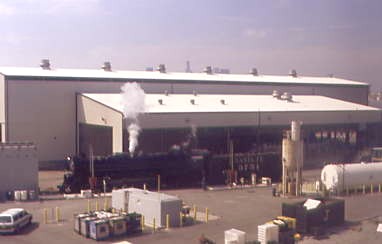
Down at the Redondo Junction Roundhouse was Santa Fe 4-8-4 3751 whistling at our train as we passed on the Metrolink Flyover prior to going to LAUPT for display. This ends my coverage of the APTA 2005 Conference in Los Angeles. A special thanks to all the members of the APTA I met but one big special thank you to Virginia Miller who arranged everything for me.